For decades, Cleveland has lamented a curse that’s always belonged to the Indians and the Indians alone.
Read MoreKen Blaze-USA TODAY Sports
Sports

Ken Blaze-USA TODAY Sports
For decades, Cleveland has lamented a curse that’s always belonged to the Indians and the Indians alone.
Read More
Indians closer Joe Borowski celebrates with catcher Kelly Shoppach after the Indians beat the Yankees in New York to advance to the 2007 ALCS against the Boston Red Sox. (mlb.com)
I wrote about romance, midges, and the return of October baseball to Cleveland
Read More
The facial expression that only a Cleveland fan can recognize. (CBS)
I wrote about the five reasons why I don't care how awful the Browns will be in 2016
Read More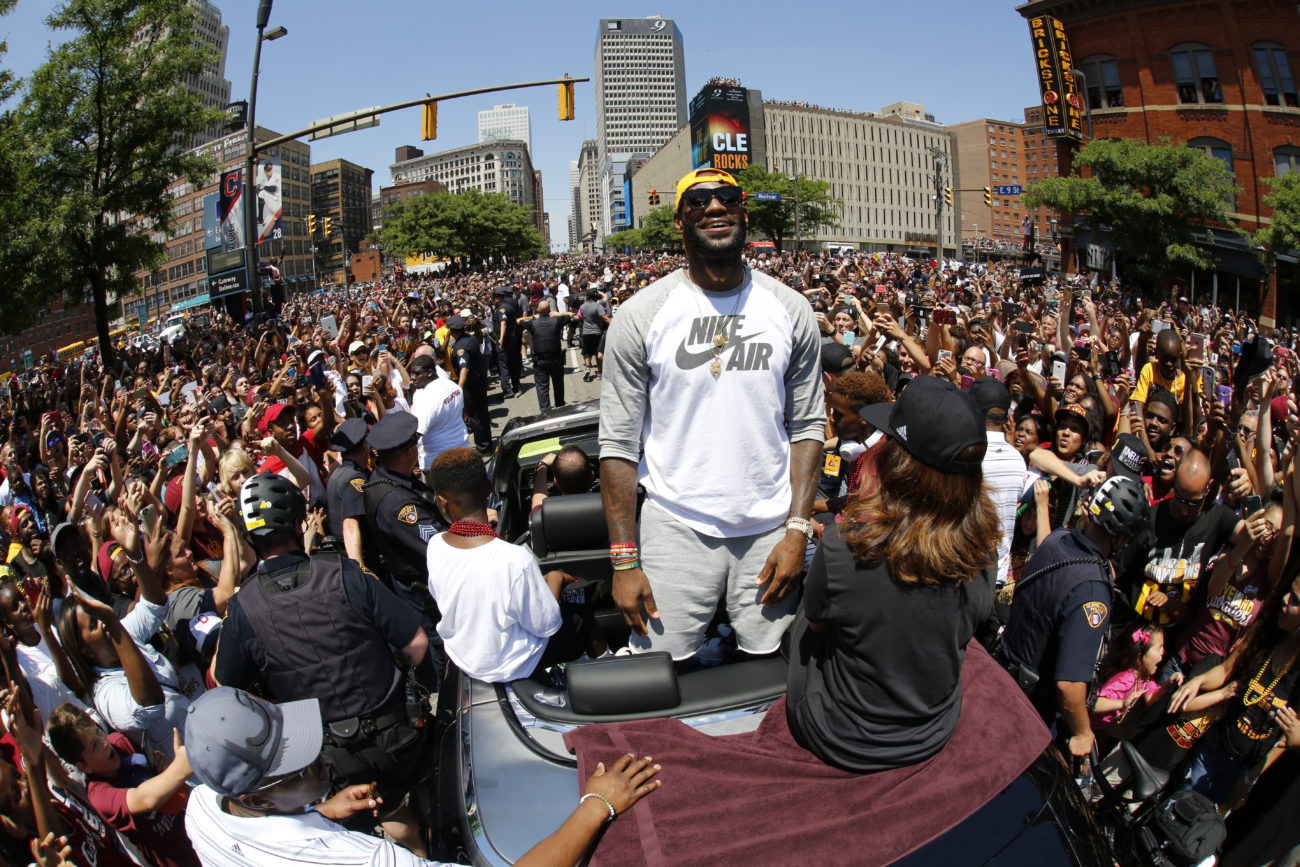
(AP Photo/Gene J. Puskar)
I wrote about my city, my sweaty clothes, and the night Cleveland was reborn
Read More
Processed with VSCOcam with hb2 preset
I wrote about curses, underdogs, and my city.
Read More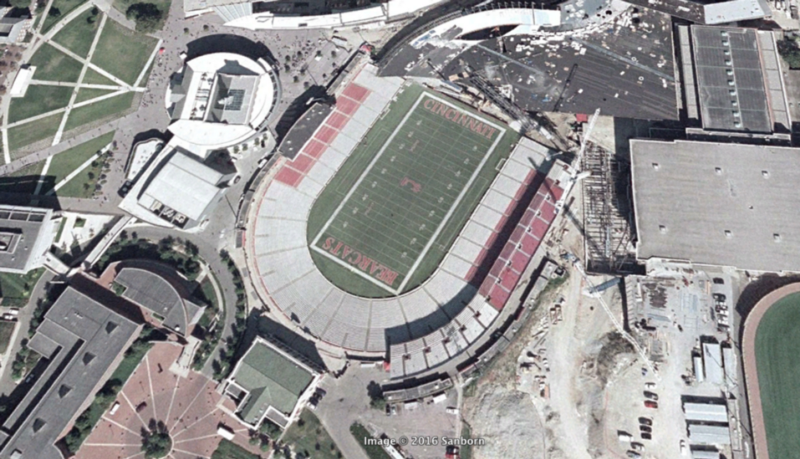
The Cincinnati Bearcats football team has called Carson Field home since 1901. They’ve been playing home games on the exact same “patch of grass” for a full 115 seasons now, making their house the second oldest playing site in college football. Nippert Stadium was completed at Carson Field in time for the 1924 season, and — although many changes have blown through campus since — it’s still home to the red and black.
Spend a few minutes playing with Google Earth and you’ll quickly learn you can get a satellite image of basically anywhere on the globe, and a full archive of images in more populated areas. The good folks at Google have an array of images of Nippert Stadium dating back to 1994, which is before many current students were born. It’s an interesting history. Let’s take a look:
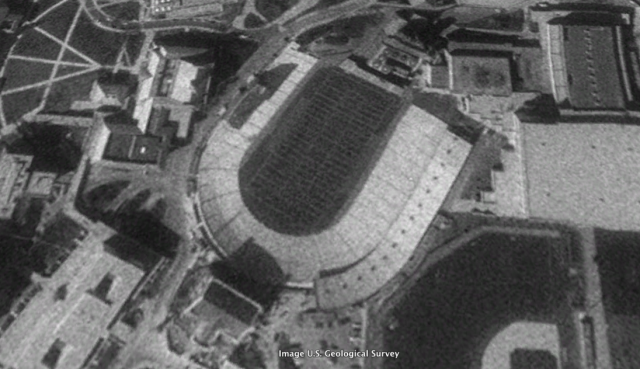
This grainy, distorted blob of an image shows a Nippert following the 1993 season in which the Bearcats finished with an 8–3 record, their first winning season following a decade of futility.
This was in the days when Carson Field was a lovely AstroTurf, which had first been installed in 1970. The field was a bright artificial green and the end zones were blank, at least as far as I can gather. It was a bleak, depressing field to match a bleak, depressing era of football.
In 1991, the new press box opened on the east side of the stadium, bringing structural updates with it. In 1992, new lighting and a scoreboard were added, the Herschede-Shank Pavilion was expanded, and capacity swelled to the 35,000 we were accustomed to for so long. By March of ’94, the bones of the stadium were set in stone for the next decade.
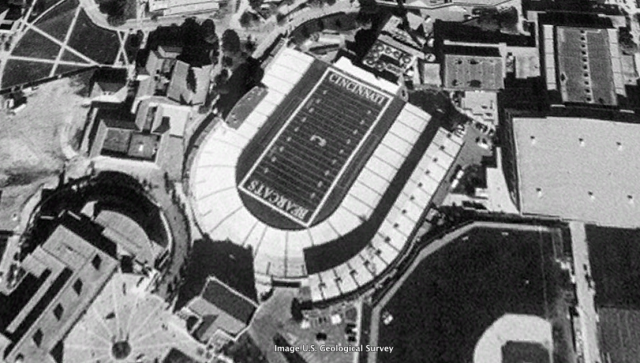
In Summer 2000, the AstroTurf was ripped out and replaced with FieldTurf, finally bringing Carson Field into the modern era. The $2.3 million athletic facility face lift also brought much needed branding to the field, and the classic Bearcats wordmarks adorned the end zones with the original C-Paw (introduced in 1990) taking center stage at the 50-yard line.
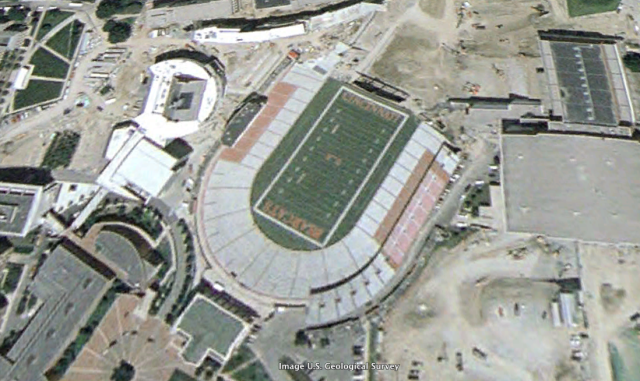

Although no work to the stadium took place during this time, the university was in the throes of the $105 million Varsity Village project that brought a massive athletic facilities overhaul to UC. With the construction of the new Campus Recreation Center, Nippert gained a new permanent grandstand on the north end of the field, now referred to as Bearcats Lair.
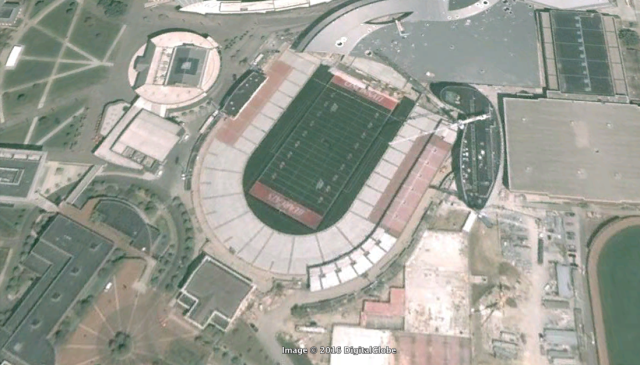
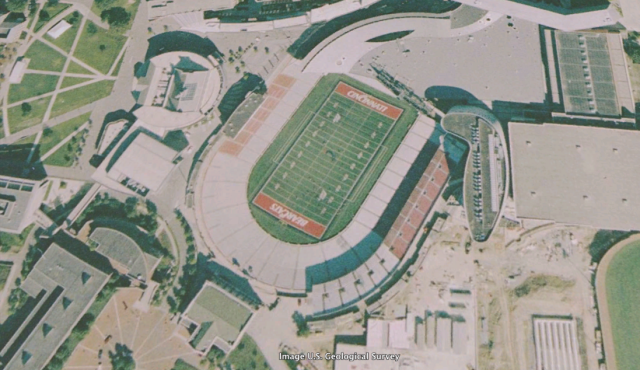
Big changes came to Clifton in the eight months between the 2004 images and the 2005 images. The new, updated C-Paw logo (still in use today) leaked to the public in March 2005 before its official unveiling in June. In July, the University of Cincinnati officially joined the Big East Conference. Nippert got brand new FieldTurf reflecting these changes over that summer, and a new video board was installed at the northeast corner of the stadium.

This is the quintessential Nippert, in my eyes. The Varsity Village project was finally completed in 2006, and the stadium and the surrounding area looked exactly like this during the rebirth of Bearcats football from 2006 thru 2012. By the time this version of Carson Field was finally laid to rest, it was really beaten down. Notice how dull and weathered the field looks.
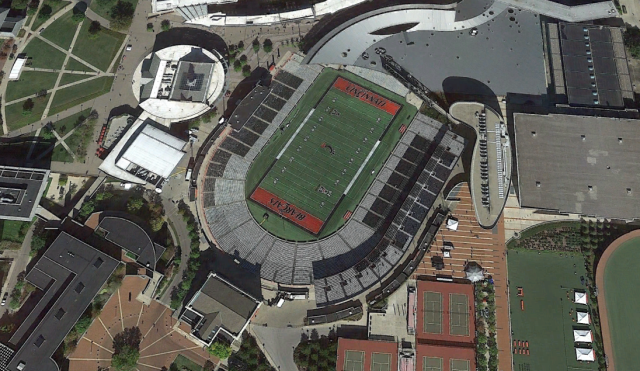
In perhaps my least favorite update in Nippert Stadium history, the Big East logos were stripped from the new field, which was installed prior to the 2013 season and the start of the Tommy Tubberville era. The American Athletic Conference logo was stamped on the new surface, UBU Sports’ Speed S5-M.
The much needed updated was bright and shiny, but the conference change wasn’t exactly what most fans liked to see.
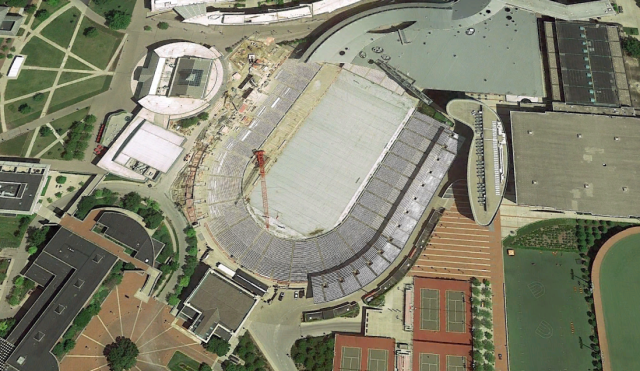
Following the 2013 season, Nippert underwent its biggest face lift since it originally opened 90 years prior. The west concourse was leveled and the team played the 2014 season at Paul Brown Stadium. In the above photo, the new Carson Field was covered with a giant tarp to protect it from construction.

The most recent satellite photo of Nippert features the current iteration of the stadium. The updated facility debuted in September 2015 and features a domineering new pavilion on the west side, new bathrooms and concessions on the east side, and spiffy new red caps on the bleachers. The black C-Paw in the student section looks really sharp from above.
In a move that nobody saw coming, 2015 was the final season with the new playing surface. It was installed in 2013, and — given that the Bearcats played downtown in 2014 — only saw two seasons of action. The turf was ripped up last week and a new playing surface is currently being installed to accommodate the Bearcats’ new roommate, (FC Cincinnati of the United Soccer League) who will call Nippert home beginning with their inaugural game next month.

Originally published at fromloveland.com on March 14, 2016.
I graduated, so I wrote about my favorite Bearcats football games as a student
Read MoreI graduated, so I wrote about my favorite Bearcats basketball games as a student
Read More
Sometimes you just need to fire off a quick #HotTake about how something is either the best thing ever or the worst thing ever. Welcome to Hot Take Express. The train is leaving the station. Don’t forget your oven mitts when handling this hot take.

These are the worst uniforms I’ve ever laid eyes on as a fan of the Cleveland Cavaliers, or any Cleveland team for that matter. These are the Tampa Bay Buccaneers of Cleveland jerseys.
I’m a bit of a uniform buff. The Cavs, if they’re going to abandon the 2003–2010 blue alternates, should at least stick to the plain ones I’ve finally gotten used to. There’s nothing exciting about their standard post-2010 jerseys, but I’ll live. Mix things up with one of the many throwbacks. Pick one. They’re all great. This is not a franchise that should be struggling for good jersey options. In fact, I may even argue that I like every single jersey the Cavs have ever worn.
So why am I watching them play in black, sleeved jerseys right now?
They look like an intramural team. If I went to the gym to play a game of HORSE, I’d be wearing the same outfit that Kevin Love is wearing right now. This is a problem. The facts back me up here: The team just shot 36% from the floor in the first half. James, Love, and Williams combined to shoot 33%. LeBron literally destroyed his jersey in order to free his biceps from their fabric prison. He tore his jersey apart like The Incredible Hulk, and then finished the job on the bench with a pair of scissors during the next timeout.
This should not be happening.
Towards the end of the 2013–14 season, LeBron officially joined the list of players on the #AntiSleeves train. After a particularly poor shooting performance against the Spurs, he complained to the media. The New York Times noted his 44.4% 2014 FG% in sleeves. Compare that to his 58.3% average for that season in the traditional sleeveless.
Now LeBron is back home in Cleveland and the Cavs are the favorites to win the NBA Title. Suspiciously, the Cavs now unveil the first sleeved jersey in franchise history. When sleeved jerseys first became trendy, the Cavs were awful and LeBron was in Miami. The sleeved abominations have never made their way to Cleveland… until this year. We all know LeBron James struggles in sleeves. The NBA knows LeBron James struggles in sleeves. Apparel outfitter Adidas knows LeBron James struggles in sleeves.
Suspicious? Yes. Conspiracy? Also yes. Illuminati? Undoubtedly.
LeBron is signed to Nike. Adidas makes the NBA jerseys. Sabotage? #Yes.
The Cavs will win the NBA Championship next June, but not if these t-shirts from hell have anything to say about it.

I wrote about the 2005 Cleveland Indians, the most lovable team of all time
Read More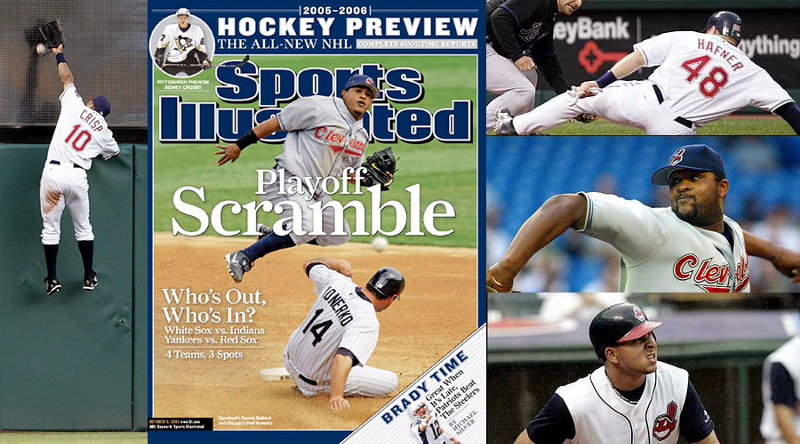
Those who know me are aware of my sports obsession. It probably borders on unhealthy at times, especially considering my loyalty to Cleveland. I love football and basketball, but for better or worse, baseball will always be my favorite. It has a special place in my heart. I started playing little league when I was four years old, and it sparked a life-long love affair.
Without giving you my life story, I was born in Cincinnati, but spent the first half of my childhood living in cities without a professional baseball team. I moved to Cleveland when I was 12, and the Tribe swept me off my feet. This was in 2004, but it was the 2005 Indians that stole my heart.
Against all odds, they won 93 games that year. Looking at that roster from a 2005 perspective, that’s absurd. This was in the post-Thome era. This was after Manny Ramirez, Omar Vizquel, and Kenny Lofton had skipped town in one way or another. This team wasn’t supposed to be special.
The 2007 Indians that fell heartbreakingly short of reaching the World Series were incredible. They were good enough to win the whole thing. The 2013 Indians were a thrill ride, crawling back from the brink on multiple occasions to squeak their way into a playoff appearance. However, the 2005 team was something different. This was just a group of unproven prospects mixed with mediocre players and a handful of budget veterans. This team winning 93 games was borderline accidental. They hadn’t had a winning record since 2001, when Jim Thome, Omar Vizquel, and Kenny Lofton were tentpoles of the organization.
Nobody told these guys they weren’t supposed to win.
A 31st round draft pick out of Texas named Travis Hafner would unload 33 HR and 108 RBI in his second full season. A magician of a 2nd baseman named Ronnie Belliard would compile a seemingly endless highlight reel of defensive plays, while unexpectedly becoming an All-Star. A baby-faced 22-year-old named Grady Sizemore would take the MLB by storm while anchoring the leadoff spot in the lineup. Homegrown prospect Jhonny Peralta would manage 24 homers in his first full season. A speedy, gritty center fielder named Coco Crisp would hit .300 while becoming a household name in Cleveland. Everybody loved Coco.
The pitching was just as scrappy. A budding superstar named CC Sabathia peeled off 15 wins. An unassuming 26-year-old named Cliff Lee would nail down 18 of his own. A chubby, 36-year-old closer named Bob Wickman would turn in the best season of his 15-year career, notching an incredible 45 saves.
Aside from pure numbers, the team was just plain fun to watch. They could do it all. They had six players with 19 or more home runs. Grady and Coco were stealing bases. It was one of the most impressive defensive teams I’ve ever seen. The fact that nobody won a Gold Glove Award that year is a sham. The Chicago White Sox had been dominating the division, but they weren’t quite sure how to handle the group of kids that the Indians had put together. Nobody in the majors was.
I attended a handful of games that year, but the one that sticks out was on the Fourth of July. The Indians played a double-header against the Detroit Tigers. I went to the second game, in which Jason Davis faced off against a young pitcher in his major league debut. Some kid named Justin Verlander. Coco hit an inside-the-park home run in the 8th inning. Hafner was the next batter up, and hit what had to be a 470ft blast. It cleared the trees in center field. To this day, it’s probably the most impressive home run I’ve seen in person. The Tribe rolled to a 6–0 win, but they were still in third place in the division, nearly ten games back on the White Sox.
On September 5th, the Tribe were coming off a loss and were looking at a 9.5 game deficit in the AL Central. They needed wins, and they needed lots of them. They responded by winning 17 out of their next 19, going 15–1 against Central Division opponents in that stretch. After a win on September 24th, they were just a game and a half back in the division with a game and a half lead over the defending champion Red Sox in the wild-card race.
With just seven games left in the season, they controlled their own destiny. The Tribe was scorching hot, and a final week of baseball stood between them and an unlikely playoff berth.
On Sunday, September 25th, Grady Sizemore lost a 9th inning fly ball in the Kansas City sun, allowing the game winning run to score. It was a tiny mistake, but it sent the team into a tailspin.
In true Cleveland fashion, they lost six of those final seven games. Five of those losses came by a single run. They finished two games behind the Red Sox in the wild-card race, missing the playoffs. It was a heartbreaking collapse, ending in a sweep at the hands of the hated White Sox, who would go on to sweep the World Series 24 days later. It was trademark Cleveland, and it hurt. The following year they finished 18 games out of first place, winning just 78 and finishing fourth in the division.
In the midst of my research/trip down memory lane, I stumbled across this New York Times article by Joe Lapointe that was published after that final game. It reads like a eulogy:
“In the clubhouse, the Indians walked among their lockers, slapping each other on the back while hugging. Outside, for more than an hour afterward, the fans — mostly children — lined up to run the bases in the late-afternoon shadows while music played.
But there were so many of them that their pace was slow, walking like mourners filing by the casket of the departed at a celebrity funeral. One of the songs playing on the speaker was an old one called ‘Kind of a Drag.’”
That team dissolved in incredible fashion. #1 minor league prospect Brandon Phillips would be traded down I-71 to the Cincinnati Reds after failing to get along with the Indians management. Belliard was traded to the Cardinals. Victor Martinez and Peralta would eventually land in Detroit together. Sizemore would string together a few more impressive seasons before falling victim to a slew of injuries, ending his tenure in Cleveland. Hafner had a career season in 2006, leading to a hefty contract, but would never crack 17 homers in his final five seasons in Cleveland. Sabathia would go on to win a Cy Young in 2007, only to be traded in 2008. Lee got his Cy Young in 2008, but was traded in 2009. Coco was traded to the Red Sox in 2006, and would record the final out against the Indians in the 2007 ALCS, ending their run at the World Series.
The pains of a small-market team are never more apparent than when looking at these Indians. If the Tribe could have afforded to keep most of these guys, I’m willing to bet we would’ve seen a World Series Trophy at some point.
The 2005 Cleveland Indians were iconic. They were the scrappy underdog that didn’t quite make it. Cleveland has seen a few incredible baseball teams in the past decade, but this version of the Tribe is still the best. Baseball seems to have a certain magic and mystique that other sports lack, and the ’05 Indians are a shining example. I’ll never forget that summer.